My Services • Tours & Excursions
Tours & Excursions in Nepal
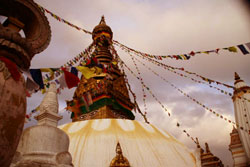 Nepal is the dreamland of the tourists and it invites, welcomes, charms and bewilders the visitors. Those who have already visited Nepal cherish the desire for a second visit and those who have heard or read about the Himalayan kingdom make a plan to visit the country.
Nepal is the dreamland of the tourists and it invites, welcomes, charms and bewilders the visitors. Those who have already visited Nepal cherish the desire for a second visit and those who have heard or read about the Himalayan kingdom make a plan to visit the country.
Nepal is also melting pot of Hindu and Buddhist culture and it serve as an unique example of tolerance and brotherhood. Many festivals of religious significance are celebrated commonly with equal enthusiasm by both the sects and there is the co-existence of all the other religious. Kathmandu and Patan contain a wide variety of temples, shrines, monasteries and medieval pagodas.
Right outside the city are numerous chances to enjoy a glimpse of rural village life the way it has been for hundreds of years. We offer opportunities for guided treks around the country with a knowledgeable and friendly trekking guide.
We also have programs designed for touring the famous religious and cultural sites of Nepal including rafting, Jungle safari and little trek. Tours are led by our knowledgeable and certified guides. Personal transportation is provided and all tours are private. So please let us introduce you to our home and history in Kathmandu.
Here are some options for guided tours in Kathmandu, Patan, Bhaktapur and other important part of the Country. These are various packages designed to give you a variety of cultural experiences during your tour.
Kathmandu Valley
Katmandu valley The bowl like Small Mountain - sheltered Kathmandu valley is the historical center of Nepal and the place where kingdoms rose and fell, palaces and temples were built and rebuilt, and Nepalese art and culture were developed and refined is equally religious. Kathmandu valley has been called on big museum - a vast store of Hindu and Buddhist art with more shrines and temples per square km than anywhere else in the world. Nepalese culture has immense vitality and countless festivals are celebrated each year. institutions such as the ''Living Goddess'' forms a direct link between the past and the present.
The valley is above 25 km from east to west and 20 km from north to south with an area of 570 square km and a population of 1.1 million. Kathmandu lies at a height of around 1300 meters while the surrounding hills range from 1500 meters to 2800 meters in height. Langtang, Ganesh Himal, Gaurishanker and Everest are visible from different points in the valley.
Patan situated across the Bagmati river to the south of Kathmandu is known to this day for its excellent works of art and carving in wood and bronze. Bhaktapur, also known as Bhadgaon, is the most medieval of the lot and is situated in the eastern part of the valley. while Kathmandu and Patan have undergone great changes in the three decades since Nepal its isolation, Bhaktapur has changed much less.
Patan:
Patan locally referred to as Lalitpur and situated at the south of Kathmandu is the second largest town valley. patan's great building boom took place under the Mallas in the 16th, 17th and 18th centuries. numerous temples of widely diverse style as well as many Buddhist monasteries are scatterd around the fascinating town. the city is famous for its crafts and metal works which are wonderful souvenirs to be carried home.
Bhaktapur:
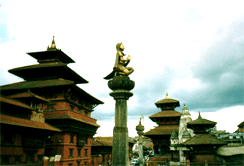 Bhaktapur also known as Bhadgaon is shaped like conch. it is a medieval city designed in the 19th century by its founder king Ananda Malla. having an area of 139 square kilometer, it is situated at 1331 meter from the sea level and 13 km far from Kathmandu on the east side, linked with a motorable road. Bhaktapur has not yet lost its old traditions but rather has maintained them very well. Bhaktapur not only grows sufficient food for the city but support Kathmandu city also. the city's craftsmen build and decorate houses, make pottery and adorn temples. from the very beginning Bhaktapur has attracted the foreigners and local tourists as well. durbar square, ''palace pf 55 windows'', Golden gate leading through to the Taleju temple, National Art gallery having a good collection of thangkas paintings - all are of immense attraction. the ancient Royal palace is remarkable and an excellent example of 18th century architecture made by king Bhupatindra Malla whose statue stands in front of the Golden Gate. Around the Durbar square the curio shops, woods and stone carvings, thangkas have become a good attraction.
Bhaktapur also known as Bhadgaon is shaped like conch. it is a medieval city designed in the 19th century by its founder king Ananda Malla. having an area of 139 square kilometer, it is situated at 1331 meter from the sea level and 13 km far from Kathmandu on the east side, linked with a motorable road. Bhaktapur has not yet lost its old traditions but rather has maintained them very well. Bhaktapur not only grows sufficient food for the city but support Kathmandu city also. the city's craftsmen build and decorate houses, make pottery and adorn temples. from the very beginning Bhaktapur has attracted the foreigners and local tourists as well. durbar square, ''palace pf 55 windows'', Golden gate leading through to the Taleju temple, National Art gallery having a good collection of thangkas paintings - all are of immense attraction. the ancient Royal palace is remarkable and an excellent example of 18th century architecture made by king Bhupatindra Malla whose statue stands in front of the Golden Gate. Around the Durbar square the curio shops, woods and stone carvings, thangkas have become a good attraction.
Nyatapola, Nepal's tallest five roofed temple, stands not far from the Durbar square. the pottery market is very near to the Nyatapola temple. the Akash Bhairav temple, the Dattaraya shrine, pujarinath with excellent wood work, the famous peacock windows located south of Dattatreya temple, the Bramayani mandir all are of equal importance and work of fine art and culture.
Nagarkot:
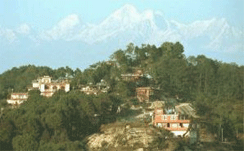 Nagarkot located about 14 km north east from Bhaktapur at the height of 1838 meter from the sea level is the best place for countryside walking and mountain viewing . It takes about an hour by car to reach from Kathmandu. On the way to Nagarkot one sees the terraced farm land and pine forest It is the only place. where from one can view a panorama of the entire eastern central Himalaya . Everest. Numbur. Chooyu. Nuptse, Lhotse Makalu and to the west Manaslu and Himalchuli five of the world's ten highest peaks. By night overlooking the charming sparkling lights of the Kathmandu valley, Nagarkot is incomparable. One can see many varieties of flowers and can enjoy the songs of the many birds in the morning . For overnight stop, there are every type of accommodation suitable for all class of tourist, budget to deluxe.
Nagarkot located about 14 km north east from Bhaktapur at the height of 1838 meter from the sea level is the best place for countryside walking and mountain viewing . It takes about an hour by car to reach from Kathmandu. On the way to Nagarkot one sees the terraced farm land and pine forest It is the only place. where from one can view a panorama of the entire eastern central Himalaya . Everest. Numbur. Chooyu. Nuptse, Lhotse Makalu and to the west Manaslu and Himalchuli five of the world's ten highest peaks. By night overlooking the charming sparkling lights of the Kathmandu valley, Nagarkot is incomparable. One can see many varieties of flowers and can enjoy the songs of the many birds in the morning . For overnight stop, there are every type of accommodation suitable for all class of tourist, budget to deluxe.
Beyond the Kathmandu Valley:
Pokhara:
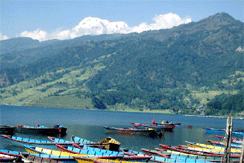 If Kathmandu is the cultural hub of Nepal, Pokhara is its center of adventure. An enchanting city nestled in a tranquil valley, it is the starting point for many of Nepal's most popular trekking and rafting destinations. The atmosphere on the shore of Phewa Lake is one of excited vitality as hipster backpackers crowd the many bars and restaurants exchanging recommendations on guest houses and viewpoints, both by the lake and above the clouds.
If Kathmandu is the cultural hub of Nepal, Pokhara is its center of adventure. An enchanting city nestled in a tranquil valley, it is the starting point for many of Nepal's most popular trekking and rafting destinations. The atmosphere on the shore of Phewa Lake is one of excited vitality as hipster backpackers crowd the many bars and restaurants exchanging recommendations on guest houses and viewpoints, both by the lake and above the clouds.
Pokhara is a place of remarkable natural beauty. The serenity of Phewa Lake and the magnificence of the fishtailed summit of Machhapuchhre (6,977 m) rising behind it create an ambience of peace and magic. At an elevation lower than Kathmandu, it has a much more tropical feel to it, a fact well appreciated by the beautiful diversity of flowers which prosper in its environs. Indeed, the valley surrounding Pokhara is home to thick forests, gushing rivers, emerald lakes, and of course, the world famous views of the Himalaya.
The powerful rule of the old kings of Kathmandu, the Lichhavis and the Mallas, held sway over this valley for some time. As these dynasties fell prey to their own troubles, Pokhara Valley and the surrounding hills disintegrated into small kingdoms, frequently at war with each other. These were called the Chaubise Rajya or the Twenty-four Kingdoms. It was among these that Kulmandan Shah established his kingdom. His descendant Drabya Shah was the first to establish Gorkha, home of the legendary Gurkha warriors.
Finally, Pokhara is part of a once vibrant trade route extending between India and Tibet. To this day, mule trains can be seen camped on the outskirts of the town, bringing goods to trade from remote regions of the Himalaya. This is the land of the Magars and Gurungs, hardworking farmers and valorous warriors who have earned world-wide fame as Gurkha soldiers. The Thakalis, another important ethnic group here, are known for their entrepreneurship.
Lumbini:
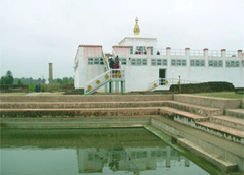 Lumbini, (the birthplace of Lord Buddha) is situated on the South-Western plains of Nepal. Lumbini gardens, dotted with holy shrines, stupas, monasteries and the temple of Maya Devi, the mother of Lord Buddha, are the principal attractions. A great pillar from 250 B.C. carries an inscription signifying the birth of Lord Buddha. Beside the Maya Devi temple to the south is a sacred pole where Lord Buddha received his first purification bath. Close to Lumbini is Tilaurakot, an archaeological site over 2000 years old.
Lumbini, (the birthplace of Lord Buddha) is situated on the South-Western plains of Nepal. Lumbini gardens, dotted with holy shrines, stupas, monasteries and the temple of Maya Devi, the mother of Lord Buddha, are the principal attractions. A great pillar from 250 B.C. carries an inscription signifying the birth of Lord Buddha. Beside the Maya Devi temple to the south is a sacred pole where Lord Buddha received his first purification bath. Close to Lumbini is Tilaurakot, an archaeological site over 2000 years old.
Tansen:
One of the largest hill towns in Nepal, Tansen (1371 m.) is some 300 km. southwest of Kathmandu. Tansen served as the capital of the tiny Kingdom of Palpa before it was annexed into the unified Nepal. Nestled on top of the highest hill in the area, Tansen offers a breathtaking view of Dhaulagiri, Annapurna, and Manasalu to the north contrasted by the forests and valley farm houses to the south. The town is rich in ancient temples and other places of historical and cultural interest.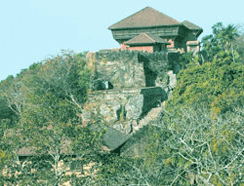
Gorkha Durbar:
This was the home of Gorkha Kings— The Kings of the present dynasty that expanded itself into modern Nepal. The Shah dynasty of Nepal descends from the Gorkhas. Located some 160 km. West of Kathrkha soldiers were originally from this area. Points of interest include ornate ancient temples and mandu, Gorkha is a picturesque hill resort steeped in ancient history. The world renowned Gothe Royal Palace.